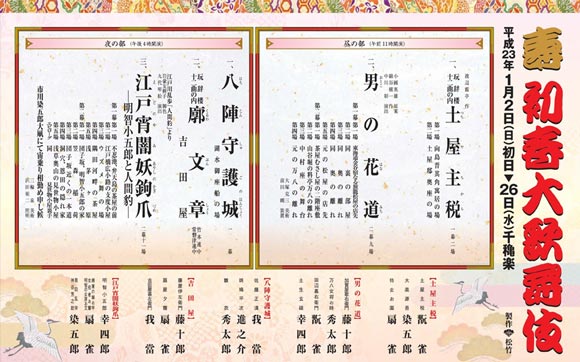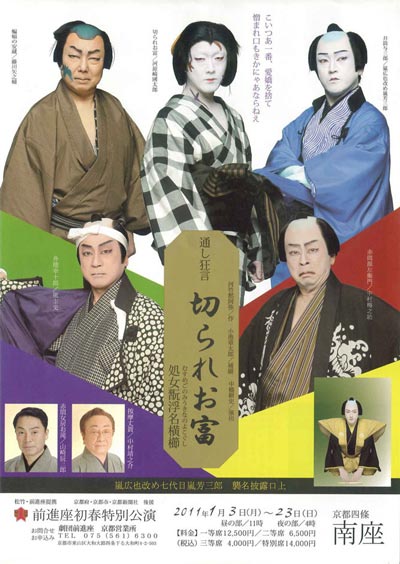| JANUARY 2011 |
|
2 in ďsaka (Sh˘chikuza), 7 shows in T˘ky˘ (National Theatre, Asakusa K˘kaid˘, Shinbashi Enbuj˘, Theatre Ginza) and 1 in Ky˘to (Minamiza)!
|
| Sh˘chikuza (ďsaka) |
| Dates | 2 ~ 26 January 2011 (Kotobuki Hatsuharu ďkabuki) Congratulation Early Spring Grand Kabuki |
| MatinÚe |
Otoko no Hanamichi |
| Evening |
Hachijin Shugo no Honj˘ (Kosui Gozabune) Edo no Yami Ayashi no Kagizume [ |
| Casting |
Sakata T˘jűr˘, Matsumoto K˘shir˘, Kataoka Gat˘, Nakamura Kanjaku, Kataoka Hidetar˘, Nakamura Senjaku, Ichikawa Somegor˘, Kataoka Shinnosuke |
| Comments |
|
 |
| National Theatre (T˘ky˘) |
| Dates | 3 ~ 27 January 2011 (Hatsuharu ďkabuki) Early Spring Grand Kabuki |
| Program | |
| Casting |
Onoe Kikugor˘, Nakamura Tokiz˘, Onoe Kikunosuke, Onoe Sh˘roku |
| Comments |
Revival at the National Theatre of Fukumori Kyűsuke I's long-forgotten kaomise drama "Shitenn˘ Oedo no Kaburaya", which was premiered in the 11th lunar month of 1815 in Edo at the Nakamuraza. |
 |
| Shinbashi Enbuj˘ (T˘ky˘) |
| Dates | 2 ~ 26 January 2011 (Kotobuki Hatsuharu ďkabuki) Congratulation Early Spring Grand Kabuki |
| MatinÚe |
Gohiiki Kanjinch˘ (Ataka no Seki) |
| Evening |
Genpei Nunobiki no Taki
|
| Casting |
Ichikawa Danjűr˘, Nakamura Kichiemon, Band˘ Mitsugor˘, Nakamura Shikan, Nakamura Tomijűr˘, Nakamura Hashinosuke, Nakamura Shibajaku, Nakamura Baigyoku, Nakamura Kaishun, Nakamura Fukusuke, Nakamura Kinnosuke, Ichikawa Danshir˘, Ichikawa Sadanji, Band˘ Yajűr˘, Nakamura Karoku, Nakamura Kash˘, Nakamura T˘z˘, Nakamura Takanosuke |
| Comments |
|
 |
|
|||
| Dates | 2 ~ 26 January 2011 (Shinshun Hanagata Kabuki) New Year Young Actors Kabuki |
||
| MatinÚe | |||
| Evening | |||
| Casting |
Ichikawa Kamejir˘, Kataoka Ainosuke, Nakamura Shichinosuke, Nakamura Kikaku |
||
| Comments |
The yearly show for young promising actors at the Asakusa K˘kaid˘ in Asakusa, a lively and colorful neighboorhood that keeps the scent of old Edo.
|
||
| Le Theatre Ginza (T˘ky˘) |
| Dates | 2 ~ 20 January 2011 (Band˘ Tamasabur˘ Tokubetsu K˘en) Band˘ Tamasabur˘ Special Performances |
| Program |
Dan no Ura Kabuto Gunki (Akoya) |
| Casting | |
| Comments |
|
|
|||
| Dates | 3 ~ 23 January 2011 (Zenshinza K˘en) | ||
| Program | |||
| Casting |
Nakamura Umenosuke, Arashi Keishi, Kawarasaki Kunitar˘, Fujikawa Yanosuke, Arashi Yoshisabur˘, Yamazaki Tatsusabur˘, Nakamura Seinosuke, Anegawa Shinnosuke, Ikushima Kigor˘, Matsunami Kihachir˘ |
||
| Comments |
Arashi Yoshisabur˘ VII celebrates his shűmei in Ky˘to at the Minamiza, playing the role of Yosabur˘ in the drama "Kirare Otomi":
|
||
 |
|
|
| Contact | Main | Top | Updates | Actors | Plays | Playwrights | Programs | Links | FAQ | Glossary | Chronology | Illustrations | Prints | Characters | Derivatives | Theaters | Coming soon | News |